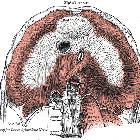Pleura


The pleura (plural: pleurae) is an exceedingly delicate serous membrane which is arranged in the form of a closed invaginated sac that encloses the lungs and lines the thoracic cavity.
Gross anatomy
The pleura divides into:
- visceral pleura which covers the surface of the lung and dips into the fissures between its lobes
- parietal pleura which lines the inner of the chest wall and named according to the site it lines:
- cervical pleura
- costal pleura
- diaphragmatic pleura
- mediastinal pleura
The visceral pleura is attached directly to the lungs, as opposed to the parietal pleura, which is attached to the opposing thoracic cavity. The space between these two delicate membranes is known as the intrapleural space (or pleural space).
The pleural fissures are formed by the visceral pleura separating two adjacent lobes:
- oblique or major fissure
- horizontal or minor fissure
- accessory fissures: formed within the same lobe
Contraction of the diaphragm causes a relative negative pressure within this space and forces the lungs to expand, resulting in passive inhalation. This process can be made forceful through the contraction of the external intercostal muscles, forcing the rib cage to expand and adding to the relative negative pressure within the intrapleural space, which causes the lungs to fill with air.
Lines of pleural reflection
The lines of pleural reflection outline where parietal pleura abruptly changes direction as it passes from one wall of the pleural cavity to another. Right and left parietal pleura reflect in an asymmetric manner due to the presence of the heart.
Above the clavicle: the pleura begin approximately 1" above the mid-point of the medial third of the clavicle
2 rib: both right and left pleural lines descend down the midline
4 rib: left pleural line deviates laterally to accommodate the heart
6 rib: both right and left pleural lines deviate laterally to accommodate the heart
8 rib: both right and left pleural lines pass midclavicular line (MCL)
10 rib: both right and left pleural lines pass midaxillary line (MAL)
12 rib: both right and left pleural lines travel posteriorly around the chest wall
The visceral pleura remains roughly two ribs higher than the lines of pleural reflection in the lower thorax (e.g. visceral pleura crosses MAL at the level of the 8th rib). The surface markings of the lines of pleural reflection are important to know as an incision or puncture along these lines can inadvertently cause a pneumothorax or a hemothorax.
Pleural recesses
The lungs do not completely fill the anterior and posterior regions of pleural cavities resulting in the formation of pleural recesses. These recesses provide potential spaces in which fluid can collect, they include:
- costodiaphragmatic recesses (also called costophrenic recesses)
- costomediastinal recesses
- phrenicomediastinal recesses
- vertebromediastinal recesses
Arterial supply
- parietal pleura is supplied by internal thoracic, intercostal and phrenic arteries
- visceral pleura is supplied by bronchial arteries
Venous drainage
- parietal: internal thoracic, intercostal and phrenic veins
- visceral: pulmonary veins
Lymphatic drainage
- lymphatic vessels drain to lymph nodes within the deep pulmonary plexus
Innervation
- costal pleura: intercostal nerves
- mediastinal and diaphragmatic pleura: phrenic nerves
Related pathology
- benign pleural disease
- malignant pleural disease
- pleural effusions
Siehe auch:
und weiter:

 Assoziationen und Differentialdiagnosen zu Pleura:
Assoziationen und Differentialdiagnosen zu Pleura:


